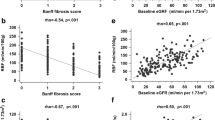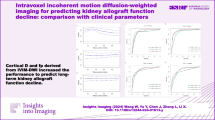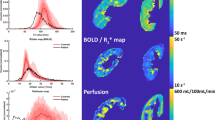Abstract
Objectives
To assess retrospectively whether diffusion-weighted magnetic resonance imaging (DW-MRI) allows physicians to determine the severity of histopathologic findings in biopsies of renal allograft patients with deteriorating renal function.
Methods
Forty consecutive kidney transplant patients underwent DW-MRI and biopsy. Patients were assigned to one group with severe and to another group with normal or mild histopathologic findings. These two groups were compared based on a qualitative DW-MRI assessment (homo-/heterogeneity) and the combination of qualitative and quantitative DW-MRI parameters (ADC, and intravoxel incoherent motion, IVIM, parameters: D, f, D*). Sensitivity, specificity, and accuracy were determined for each parameter.
Results
Biopsy findings were severe in 25 patients and normal or mild in 15 patients. Qualitative DW-MRI led to a sensitivity of 44.0% and a specificity of 93.3%. Combined qualitative and quantitative DW-MRI led to an accuracy of 80% for both the minimal ADC (ADCmin) and the minimal perfusion fraction (fmin) with a sensitivity of 84.0% and 92.0% and a specificity of 73.3% and 60.0%, respectively.
Conclusion
Combined qualitative and quantitative DW-MRI might allow physicians to determine the severity of histopathologic findings in biopsies of a high number of kidney transplant patients.
Key points
• Qualitative DW-MRI is highly specific when predicting the severity of kidney transplant biopsy.
• Allografts appearing heterogeneous on ADC are associated with severe histopathologic findings.
• Combining qualitative and quantitative DW-MRI parameters improves the classification’s sensitivity and accuracy.
• Kidney transplant biopsies might be spared by combining qualitative and quantitative DW-MRI.



Similar content being viewed by others
Abbreviations
- DW-MRI:
-
Diffusion-weighted MRI
- Mild histopathologic changes:
-
Grade I interstitial fibrosis and tubular atrophy
- Severe histopathologic changes:
-
Grades II-III interstitial fibrosis and tubular atrophy rejection, and other changes not due to rejection such as glomerulonephritis, IgA nephropathy, BK virus nephropathy, acute tubular necrosis, and cyclosporine toxicity
- ADC:
-
Apparent diffusion coefficient
- IVIM:
-
Intravoxel incoherent motion
- f :
-
Perfusion fraction
- D* :
-
Pseudo-diffusion coefficient
- D :
-
True diffusion coefficient
- s-Crea:
-
Serum creatinine
- ROIs:
-
Regions of interest
- ROC:
-
Receiver operating characteristic
References
Wilczek HE (1990) Percutaneous needle biopsy of the renal allograft. A clinical safety evaluation of 1129 biopsies. Transplantation 50:790–797
Furness PN, Philpott CM, Chorbadjian MT et al (2003) Protocol biopsy of the stable renal transplant: a multicenter study of methods and complication rates. Transplantation 76:969–973
Schwarz A, Gwinner W, Hiss M et al (2005) Safety and adequacy of renal transplant protocol biopsies. Am J Transplant 5:1992–1996
Group KDIGOKTW (2009) KDIGO clinical practice guideline for the care of kidney transplant recipients. Am J Transplant 9:S1–S155
Racusen LC, Solez K, Colvin RB et al (1999) The Banff 97 working classification of renal allograft pathology. Kidney Int 55:713–723
Nadalo LA, Dickerman RM, Slonim SM Imaging in kidney transplantation complications. http://emedicine.medscape.com/article/378801-overview. Accessed 16 Jul 2014
Thoeny HC, Zumstein D, Simon-Zoula S et al (2006) Functional evaluation of transplanted kidneys with diffusion-weighted and BOLD MR imaging : initial experience. Radiology 241:812–821
Eisenberger U, Thoeny HC, Binser T et al (2010) Evaluation of renal allograft function early after transplantation with diffusion-weighted MR imaging. Eur Radiol 20:1374–1383
Eisenberger U, Binser T, Thoeny HC et al (2014) Living renal allograft transplantation: diffusion-weighted MR imaging in longitudinal follow-up of the donated and the remaining kidney. Radiology 270:800–808
Abou-El-Ghar ME, El-Diasty TA, El-Assmy AM et al (2012) Role of diffusion-weighted MRI in diagnosis of acute renal allograft dysfunction: a prospective preliminary study. Br J Radiol 1–6
Marckmann P, Skov L, Rossen K et al (2006) Nephrogenic systemic fibrosis: suspected causative role of gadodiamide used for contrast-enhanced magnetic resonance imaging. J Am Soc Nephrol 17:2359–2362
Le Bihan D, Breton E, Lallemand D et al (1986) MR imaging of intravoxel incoherent motions: application to diffusion and perfusion in neurologic disorders. Radiology 161:401–407
Schindelin J, Rueden CT, Hiner MC et al (2015) The ImageJ ecosystem: an open platform for biomedical image analysis. Mol Reprod Dev 82:518–529
Baxter GM (2001) Ultrasound of renal transplantation. Clin Radiol 56:802–818
Charles JH (2007) Heptinstall's pathology of the kidney, 6th edn. Lippincott Wiliams & Wilkins, Philadelphia
Wu HH, Jia HR, Zhang Y, Liu L et al (2015) Monitoring the progression of renal fibrosis by T2-weighted signal intensity and diffusion weighted magnetic resonance imaging in cisplatin induced rat models. Chin Med J 128:626–631
Siegel M, Glanz S, Gordon DH, Butt KM (1981) Focal angiographic findings in renal transplant rejection. Urol Radiol 3:97–100
Kurtkoti J, Sakhuja V, Sud K et al (2008) The utility of 1- and 3-month protocol biopsies on renal allograft function: a randomized controlled study. Am J Transplant 8:317–323
Haas M, Sis B, Racusen LC et al (2014) Banff 2013 meeting report: inclusion of c4d-negative antibody-mediated rejection and antibody-associated arterial lesions. Am J Transplant 14:272–283
Lima M, Le Bihand D (2016) Clinical intravoxel incoherent motion and diffusion MR imaging: past, present, and future. Radiology 278:13–32
Blondin D, Lanzman RS, Mathys C et al (2009) Functional MRI of transplanted kidneys using diffusion-weighted imaging. Röfo 181:1162–1167
Lanzman RS, Wittsack H-J, Martirosian P et al (2010) Quantification of renal allograft perfusion using arterial spin labeling MRI: initial results. Eur Radiol 20:1485–1491
Lanzman RS, Ljimani A, Pentang G et al (2013) Kidney transplant: functional assessment with diffusion-tensor MR imaging at 3T. Radiology 266:218–225
Fan WJ, Ren T, Li Q et al (2016) Assessment of renal allograft function early after transplantation with isotropic resolution diffusion tensor imaging. Eur Radiol 26:567–575
Liu Z, Xu Y, Zhang J et al (2015) Chronic kidney disease: pathological and functional assessment with diffusion tensor imaging at 3T MR. Eur Radiol 25:625–660
Seif M, Eisenberger U, Binser T et al (2016) Renal blood oxygenation level-dependent imaging in longitudinal follow-up of donated and remaining kidneys. Radiology 279:795–804
Hueper K, Khalifa AA, Brasen JH et al (2016) Diffusion-Weighted imaging and diffusion tensor imaging detect delayed graft function and correlate with allograft fibrosis in patients early after kidney transplantation. J Magn Reson Imaging 44:112–121
Acknowledgements
We would like to thank Peter Vermathen; PhD for setting up the MRI protocols.
Author information
Authors and Affiliations
Corresponding author
Ethics declarations
Guarantor
The scientific guarantor of this publication is Harriet C. Thoeny.
Conflict of interest
The authors of this manuscript declare no relationships with commercial companies.
Funding
The authors state that this work has not received any funding.
Statistics and biometry
S. Barbieri and M. Ith kindly provided statistical advice for this manuscript.
Both of the authors do have statistical expertise.
No complex statistical methods were necessary for this paper.
Ethical approval
Institutional Review Board approval was obtained.
Informed consent
Written informed consent was waived by the Institutional Review Board.
Methodology
• retrospective
• diagnostic or prognostic study/observational/experimental
• performed at one institution
Rights and permissions
About this article
Cite this article
Steiger, P., Barbieri, S., Kruse, A. et al. Selection for biopsy of kidney transplant patients by diffusion-weighted MRI. Eur Radiol 27, 4336–4344 (2017). https://doi.org/10.1007/s00330-017-4814-z
Received:
Revised:
Accepted:
Published:
Issue Date:
DOI: https://doi.org/10.1007/s00330-017-4814-z




